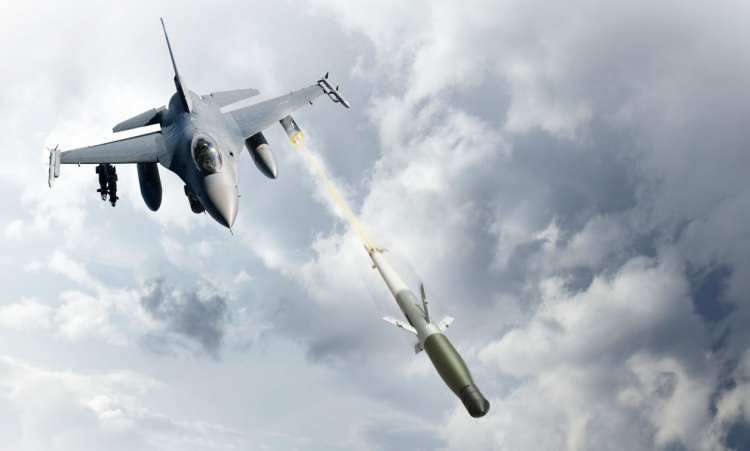The AGM-181 LRSO missile will modernize America’s nuclear triad
- By Alex Hollings
Share This Article

In October 2023, we learned that the United States had secretly been testing a new nuclear weapon with sufficient capabilities to keep the long-serving and non-stealthy B-52 Stratofortress a vital part of America’s nuclear triad for decades to come: the AGM-181 Long Range Stand Off Weapon (LRSO).
This highly secretive nuclear cruise missile is expected to offer a low-observable design meant to limit chances of intercept. It will be powered by air-breathing jet propulsion capable of carrying it to targets well in excess of 1,500 miles away. It will have an adjustable (or “dial-a-yield) W80-4 nuclear warhead capable of unleashing a five-kiloton blast (about one-third the power of the bomb dropped on Hiroshima), or a much larger 150-kiloton blast (about 10 times the power of the Hiroshima bomb)
The LRSO is slated to replace America’s aging fleet of AGM-86B Air Launched Cruise Missiles (ALCM) that have been in service since 1982, therefore, they are considered to be far less survivable than more modern cruise missiles.
Development of the weapon began in 2017 and by the fall of 2023 it was reported that it had successfully completed nine flight tests and was maturing ahead of schedule – something rather uncommon for secretive Defense acquisitions. Meanwhile, America’s new Columbia-class ballistic missile submarine and Sentinel ICBM programs have both overextending their budgets and their timetables by a wide margin. This suggests that the LRSO may be the only element of America’s nuclear modernization effort that has been progressing smoothly.
Related: Anduril’s Roadrunner is a unique reusable missile interceptor
This weapon is being designed primarily to serve as a long-range portion of the airborne leg of America’s nuclear triad, but the Defense Department has not ruled out the possibility of also fielding a conventionally armed variant for more tactical strikes.
Early documents suggest plans to produce 1,020 missiles for service with 67 additional test articles, but it’s unclear if those figures have shifted in the years since the program’s announcement.
Like the Sentinel ICBM program, the pressing need and the strategic importance of the LRSO is less about fielding an entirely new capability, and more about maintaining an existing capability in the face of adversaries’ technological advancements and obsolescence of America’s older systems.
The AGM-86, which will be replaced by the LRSO missile, was originally envisioned as operating into the 1990s, when it was to be replaced by the longer-ranged, stealthier, and more broadly capable AGM-129 Air-launched Cruise Missile (ACM) that first entered service in 1990.
However, after the fall of the Soviet Union in 1991, concerns about nuclear war diminished. And by the mid-2000s, the decision was made to retire all of America’s most expensive AGM-129s and reduce the the overall fleet of nuclear cruise missiles to approximately 528 dated AGM-86s. Like the Minuteman III ICBM, lifetime extension efforts have aimed to keep the AGM-86 viable in the modern era, but the weapon has simply reached the limits of its upgradability.
The LRSO’s total range, top speed, and estimated radar return all remain classified.
Read more from Sandboxx News
- The Switchblade, loitering munitions, and the new terrifying face of warfare
- Boeing has managed to win the contract for America’s NGAD fighter
- 3 new television shows to watch to make service time pass faster
- America’s first 6th-gen fighter jet will be Boeing’s F-47, Trump just announced
- Everything they got wrong about the Harrier in “True Lies”
Related Posts
Sandboxx News Merch
-

‘Sandboxx News’ Dad Hat
$27.00 Select options This product has multiple variants. The options may be chosen on the product page -

‘AirPower’ Golf Rope Hat
$31.00 Select options This product has multiple variants. The options may be chosen on the product page -

F-35 ‘Lightning’ Framed Poster
$45.00 – $111.00 Select options This product has multiple variants. The options may be chosen on the product page

Alex Hollings
Alex Hollings is a writer, dad, and Marine veteran.
Related to: Airpower

A Green Beret remembers his favorite foreign weapons

Navy will soon announce the contract award for its F/A-XX 6th-generation jet, according to reports

America’s new air-to-air missile is a drone’s worst nightmare

What we can deduce about the Boeing F-47 and its capabilities so far
Sandboxx News
-

‘Sandboxx News’ Trucker Cap
$27.00 Select options This product has multiple variants. The options may be chosen on the product page -

‘AirPower’ Classic Hoodie
$46.00 – $48.00 Select options This product has multiple variants. The options may be chosen on the product page -

‘AirPower’ Golf Rope Hat
$31.00 Select options This product has multiple variants. The options may be chosen on the product page -

‘Sandboxx News’ Dad Hat
$27.00 Select options This product has multiple variants. The options may be chosen on the product page
